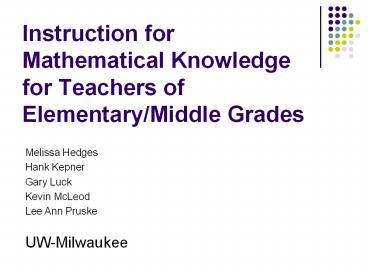Instruction for Mathematical Knowledge for Teachers of ElementaryMiddle Grades - PowerPoint PPT Presentation
1 / 20
Title:
Instruction for Mathematical Knowledge for Teachers of ElementaryMiddle Grades
Description:
UWM Foundational Courses for 1-8 Education Majors ... Plots (line plots; histograms; stem-and-leaf plots; box-and-whisker plots) ... – PowerPoint PPT presentation
Number of Views:86
Avg rating:3.0/5.0
Title: Instruction for Mathematical Knowledge for Teachers of ElementaryMiddle Grades
1
Instruction for Mathematical Knowledge for
Teachers of Elementary/Middle Grades
Melissa Hedges Hank Kepner Gary Luck Kevin
McLeod Lee Ann Pruske UW-Milwaukee
2
UWM Foundational Courses for 1-8 Education Majors
- MATH 175 Mathematical Explorations for
Elementary Teachers, I - MATH 175 Mathematical Explorations for
Elementary Teachers, II - CURRINS 331 Teaching of Mathematics Grades 1-6
- CURRINS 332 Teaching of Mathematics Middle
School
3
UWM Math Focus Courses for 1-8 Education Majors
- MATH 275 Problem-Solving and Critical Thinking
- MATH 276 Algebraic Structures
- MATH 277 Geometry
- MATH 278 Discrete Probability and Statistics
- (Over 40 of UWM 1-8 Education Majors choose a
mathematics focus area)
4
Course Design Team Model
- Mathematics faculty member ensures rigorous
content - Mathematics Education faculty member ensures
strong pedagogy, and alignment with standards - Teacher-in-Residence provides connection to
classroom practice
5
Topics Covered in MATH 175
- Problem-solving
- Number systems
- Fractions
- Decimals and percent
- Addition and Subtraction (meaning, and
properties) - Multiplication and Division (meaning, and
properties)
6
Geometry Topics Covered in MATH 176
- Visualization (solids nets)
- Angles, circles, spheres, triangles, polygons
- Constructions (patty paper Cabri on TI-84)
- Congruence and similarity
- Transformations (flips, slides, turns patty
paper Cabri) - Measurement
- Area (derivation of formulas Pythagoras)
7
Probability and Statistics Topics Covered in MATH
176
- Plots (line plots histograms stem-and-leaf
plots box-and-whisker plots) - Mean, median, mode standard deviation
- Inference
- Displaying outcomes (arrays trees sample
spaces) - Probability (experimental theoretical)
- Simulation (ProbSim applications on TI-84)
- Games (fair/unfair relationship to probability)
- Counting principles
- Expected value
8
Mathematical Topics Covered in CURRINS 331/2
- CURRINS 331 Number and operations (number
development, place value, CGI, operation
concepts) Computing devices Algebraic reasoning
(patterns, computational/relational thinking) - CURRINS 332 Geometry Algebra (linear
equations) Probability Fractions, decimals and
percents
9
1-8 Teacher Content
- If we spin the spinner shown below many, many
times, how many points would we average per spin? - What is your guess? _____
3
8
1
10
1-8 Teacher Content
- Lets begin with an easier example Perhaps it
will lead us to an answer to the previous
question. - If we spin the spinner shown below many, many
times, how many points would we average per spin? - What is your guess? ____ Why?
3
8
1
11
1-8 Teacher Content
- What are the similarities and the differences in
these 2 problems? - Similarities Differences
12
1-8 Teacher Content
- Suppose we would do a simulation of this problem.
- Draw a frequency histogram that you might expect
to get from spinning the spinner 100 times - Why did you construct the histogram as you did?
13
1-8 Teacher Content
- One such simulation produced the following
results
50
10
1
3
8
14
1-8 Teacher Content
- Now, calculate the experimental average points
per spin from the data collected
15
1-8 Teacher Content
- Now, lets calculate the theoretical number of
points per spin (or the Expected Value)
16
1-8 Teacher Content
- To calculate the Expected Value, we might
consider the following
17
1-8 Teacher Content
- What is the relationship between the 2 previous
examples? - 1 x 1 3 x 1 8 x 2 1 3 16 20 5
- 4 4
4 - 1 x ¼ 3 x ¼ 8 x ½ ¼ ¾ 4 5
- Are these procedures equivalent?
- Compare this to the calculation of the
experimental average. - 1 x 22 2 x 26 8 x 52 490 4.9
- 100 100
18
1-8 Teacher Content
- What topics in mathematics for K-8 teachers did
we address in this activity?
19
Changes to MATH 175/6
- Stabilization of instruction (hiring of Luck,
Mandell) - Improved instruction modeling pedagogy
- More hands-on activities (e.g. patty paper),
resulting in greater familiarity in CURRINS 331/2
20
Changes to CURRINS 331/2
- Prerequisite of C or better in MATH 176
- Stronger connections to the mathematics taught in
MATH 175/6, including - Greater emphasis on mathematical concepts
(distributive law, not FOIL expressions vs.
equations opposite vs. inverse) - Greater emphasis on correct notation (use of
sign to indicate balance) - Use of definitions from MATH 175/6 textbook































